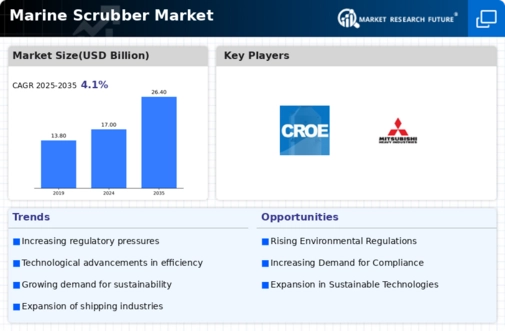Top Industry Leaders in the Marine Scrubber Market

*Disclaimer: List of key companies in no particular order
Latest Company Updates:
Key Players and Their Strategies:
Global Giants: Leading the charge are established engineering powerhouses like Wärtsilä, Alfa Laval, and MAN Energy Solutions. These players leverage their extensive experience, established distribution networks, and diverse product portfolios to cater to varied customer needs. Their strategies focus on continuous technological advancements, optimizing efficiency and minimizing operational costs of their scrubber systems. For instance, Wärtsilä's focus on hybrid scrubber technology aims to address concerns about freshwater usage and sludge disposal.
Regional Champions: Emerging regional players like Yara Marine Technologies in Europe and Shanghai Bluesoul in China are gaining traction by offering cost-effective solutions tailored to specific regional regulations and vessel types. Yara Marine's emphasis on closed-loop scrubber systems aligns with stricter wastewater discharge regulations in Europe, while Shanghai Bluesoul's focus on retrofitting solutions caters to the large fleet of older vessels in Asia.
Innovation Mavericks: Disruptive startups like Green Tech Marine and Eco Marine Power are shaking things up with novel scrubber designs and alternative technologies. Green Tech Marine's focus on compact and modular scrubber systems caters to space-constrained vessels, while Eco Marine Power's hybrid wind scrubber technology offers a fuel-efficient and environmentally friendly option. These emerging players challenge established norms and push the boundaries of scrubber technology, driving innovation across the market.
Factors for Market Share Analysis:
Technology Leadership: Offering advanced scrubber systems with high efficiency, low operational costs, and environmentally friendly features like closed-loop functionality will be crucial for gaining market share. Players actively investing in research and development hold an advantage.
Regional Expertise: Understanding the nuances of regional regulations and catering solutions to specific vessel types operating in those regions will be key. Players with strong regional presence and partnerships will have an edge.
After-Sales Service: Providing reliable and efficient after-sales service, including spare parts availability and technical support, is essential for building customer loyalty and repeat business, especially in remote maritime environments.
Cost Competitiveness: Balancing advanced technology with affordability will be crucial to attract price-sensitive shipowners, particularly in emerging markets. Players offering cost-effective solutions without compromising on quality will stand out.
New and Emerging Trends:
Hybrid Scrubber Systems: Combining scrubber technology with alternative solutions like wind power or exhaust gas recirculation offers improved efficiency and reduced emissions, aligning with stricter environmental regulations. This trend presents significant growth potential for innovative players.
Digitalization and Automation: Integrating scrubber systems with onboard sensors and data analytics platforms enables real-time performance monitoring, optimizing efficiency and minimizing operational costs. Players embracing digitalization will be well-positioned for future growth.
Focus on Alternative Fuels: The rise of alternative fuels like LNG and hydrogen in the maritime industry necessitates the development of compatible scrubber technologies. Players addressing this evolving landscape will gain a competitive edge.
Overall Competitive Scenario:
The marine scrubber market is a dynamic and complex space, characterized by intense competition between established players, regional champions, and innovative disruptors. Technological advancements, evolving regulations, and a shift towards sustainable solutions are shaping the market landscape. To succeed in this turbulent sea, players must adapt their strategies, embrace innovation, and build strong regional expertise. Those who navigate these winds skillfully will be best positioned to capitalize on the significant growth opportunities that lie ahead.
Alfa Laval (Sweden):
• December 2023: Secured a contract to supply its PureSOx scrubber system for a series of newbuild container vessels. (Source: Alfa Laval press release)
Hamon Research-Cottrell Inc. (Belgium):
• November 2023: Signed a partnership agreement with a Chinese shipyard to offer retrofit scrubber installations. (Source: Hamon Research-Cottrell press release)
Damen Shipyards Group N.V. (Netherlands):
• August 2023: Delivered a newbuild vessel equipped with a custom-designed scrubber system integrated into the ship's design. (Source: Damen Shipyards press release)
VDL AEC Maritime B.V. (Netherlands):
• July 2023: Expanded its service portfolio to include scrubber retrofitting and maintenance. (Source: VDL AEC Maritime press release)
Langh Tech Oy Ab (Finland):
• June 2023: Achieved IMO Tier III compliance certification for its Aquarius scrubber system. (Source: Langh Tech press release)
Top listed global companies in the industry are:
Kwangsung Co. Ltd. (Mexico)
Alfa Laval (Sweden)
Hamon Research-Cotfrell Inc. (Belgium)
C Ocean Engineering (US)
Damen Shipyards Group N.V. (Netherlands)
VDL AEC Maritime B.V. (Netherlands)
Langh Tech Oy Ab (Finland)
Ecospray Technologies S.r.l. (Italy)
DuPont (US)
Yara International ASA (Norway)
Clean Marine AS (Norway)
Shanghai Bluesoul Environmental Technology Co., Ltd. (China)
Fuji Electric Co., Ltd. (Japan)
Mitsubishi Heavy Industries, Ltd. (Japan)
Wartsila (Finland).

